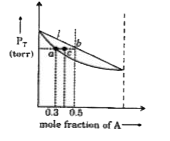Calculate the glancing angle on the cube (100) of a rock salt (a=28.14nm) corresponding to second order diffraction maximum for X-rays of wavelength 14.07 nm.Solution in Malayalam
20∘
30∘
60∘
80∘
The correct Answer is:B
First determine the distance between lattice plane by using the following expression,
dhkI=a√h2+k2+12=2.814Å, h=1, k=0, 1=0
∴d100=2.814Å√12+02+02=2.814Å=2.814×10−8cm
Using Bragg.s Eqn., nλ=2dsinθ
2×2.814×10−8sinθ=2×1.407×10−8
sinθ=2×1.407×10−82×2.814×10−8=0.5
sin30=0.5,θ=30∘.
Topper's Solved these Questions
- SOLID STATEBOOK - BRILLIANT PUBLICATIONCHAPTER - SOLID STATEEXERCISE - LEVEL-3 (Multiple Correct Answer Type)
13 Videos
- SOLID STATEBOOK - BRILLIANT PUBLICATIONCHAPTER - SOLID STATEEXERCISE - LEVEL-3 (Matching Column Type)
5 Videos
- SOLID STATEBOOK - BRILLIANT PUBLICATIONCHAPTER - SOLID STATEEXERCISE - LEVEL-2
46 Videos
- REDOX REACTION & ELECTROCHEMISTRYBOOK - BRILLIANT PUBLICATIONCHAPTER - REDOX REACTION & ELECTROCHEMISTRYEXERCISE - QUESTION (ELECTROCHEMISTRY) (LEVEL -II) (ASSERTION-REASON)
3 Videos
- SOLUTIONSBOOK - BRILLIANT PUBLICATIONCHAPTER - SOLUTIONSEXERCISE - Level-III (Linked Comprehension Type)
12 Videos
Similar Questions
Which of the following statements are correct ?
View SolutionMatch the crystal systems/unit cells mentioned in Column I with their characteristic features mentioned in Column II.

View SolutionIn NaCl type structure, if all ions along an axis joining centres of the opposite face centers are missing, the expression for packing fraction in limiting case is:
View SolutionAssertion: After the electrolysis of aqueous CuSO4 solution pH decreases.
Reason: Sulphuric acid is formed.
View Solution1 mole of A and 1 mole B are mixed together to form an ideal solution at 25∘C. Solution is placed in a vessel fitted with piston. If pressure on the solution is reduced isothermally.

Correct relationship between P∘AandP∘B is
View SolutionA monochromatic beam falls on a reflection grating with period d=1.0mm at a glancing angle α0=1.0∘. When it is diffracted at a glancing angle α=3.0∘ a Fraunhofer maximum of second order occurs. Find the wavelength of light.
View SolutionA beam of X -rays with wavelength lambda falls at a glancing angle 60.0^(@) on a linear chain of scattering centres with period a . Find the angles of incidence corresponding to all diffraction maxima if lambda = 2a//5 .
View SolutionIn Bragg's X-rays diffraction studies , 100 pm has second - order diffraction at glancing angle of 30∘ Its interplanar spacing will be
View SolutionA diffracting grating 1 cm wide has 1200 lines and is used in second order. What is the diffraction angle for light of wavelength 550 nm?
View SolutionFor a cyrstal, the angle of diffraction (2 theta) is 90(@) and the second order line has a d value of 2.28Å. The wavelength (inÅ) of X-rays used for Bragg's diffraction is
View SolutionDiffraction angle 2 theta equal to 14.8 ^(@) for a crystal having interplanar distance in the crystal is 0.400 nm when second order diffraction was observed. Calculate the wavelength of X-ray used.
View SolutionFor a crystal, the angle of diffraction (20) is 90∘ and the second order line has a d value of 2.28A∘. The wavelength (in A∘) of X-rays used for Bragg's diffraction is
View SolutionA crystal diffracts monochromatic x-rays. If the angle of diffraction of the second order is 90^(@) , then that for the first order will be
View SolutionThe wavelength of X-rays is in the order of
View SolutionDiffraction angle 2 theta equal to 14.8^@ for a crystal having interplanar distance in the crystal is 0.400 nm when second order diffraction was observed. Calculate the wavelength of X-ray used
View SolutionCalculate the angle at which (a) first order reflection and (b) second order reflection will occur in an X-ray spectrometer when X-ray of wavelength 1.54A∘ are diffracted by the atoms of a crystal, given that the interplanar distance is 4.04A∘.
View Solution
